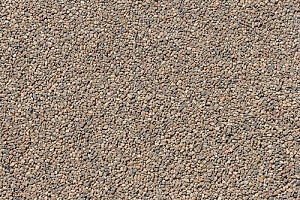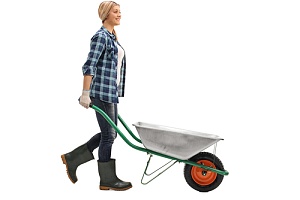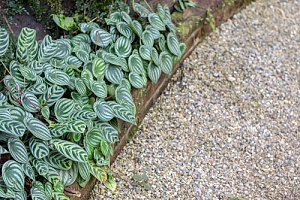 Pea gravel is a fast and inexpensive solution to create your own backyard patio. Versatile and easy to install, pea gravel can be used to prevent weeds, improve drainage, and reduce erosion. It is also easily maintained and requires just a rake to pull the stones into place. Compared to its larger stone counterparts, pea gravel is easy to walk on and features round edges that will not hurt your feet. Pea gravel can also be mixed with other types of stones to create a custom look. Learn how to make a pea gravel patio using just a few tools and materials found at your local home improvement store.
Pea gravel is a fast and inexpensive solution to create your own backyard patio. Versatile and easy to install, pea gravel can be used to prevent weeds, improve drainage, and reduce erosion. It is also easily maintained and requires just a rake to pull the stones into place. Compared to its larger stone counterparts, pea gravel is easy to walk on and features round edges that will not hurt your feet. Pea gravel can also be mixed with other types of stones to create a custom look. Learn how to make a pea gravel patio using just a few tools and materials found at your local home improvement store.
1. Gather Your Supplies
To make a pea gravel patio, you will need the following tools and supplies:
- Pea gravel
- Fill dirt
- Pressure treated lumber
- Grass killer
- Weed barrier landscape fabric
- Measuring tape
- Shovel
- Rake
- Wheelbarrow
- Hammer
- Spray paint
 2. Measure and Prepare the Area
2. Measure and Prepare the Area
Start by choosing where you would like to put the patio and how large it will be. Measure the area with the measuring tape and keep these dimensions handy for later. Using your can of spray paint, create an outline of where the patio will be. If the land is uneven, you will want to flatten it out before adding the pea gravel.
While you can dig up part of the yard to even it out, an easier alternative is to add fill dirt. Fresh fill dirt can help you create even terrain that is consistent across the entire patio area. Having an even patio is crucial to prevent tripping hazards and to make a more attractive patio.
3. Spray Weed Killer
The last thing you want to have is weeds popping through the pea gravel, ruining the aesthetic of your new patio. Weed killer can be used to help prevent new weeds from growing. When shopping for weed killer, look for a product that is designed for use on lawns. If the area that needs to be covered is fairly large, you may want to consider using a spread to evenly distribute the product. Weed killers are typically effective in killing crabgrass, dandelions, clovers, and nutsedge.
4. Dig Out the Border and Lay Your Wood
You want your wood border to be set in the ground a little bit for stability. Start by putting your lumber into the shape you want in your yard. You can have the wood measured to your specified size at your local home improvement store or you can do it yourself at home. Once the wood is laid out, use corner brackets to attach the lumber together. Screw in the brackets on the bottom side of the wood to keep them out of sight. Using a shovel, dig out the border and lay your wood into the ground. Use extra fill dirt to fill in any gaps around the border.
5. Roll Out the Weed Barrier Landscape Fabric
 With the border in place, it is time to roll out your weed barrier landscape fabric. Having landscape fabric under the pea gravel acts as an extra safeguard to ensure weeds do not survive the weed killer and pop up between the stones. Landscape fabric typically comes in large rolls of fabric-like material that easily rolls out.
With the border in place, it is time to roll out your weed barrier landscape fabric. Having landscape fabric under the pea gravel acts as an extra safeguard to ensure weeds do not survive the weed killer and pop up between the stones. Landscape fabric typically comes in large rolls of fabric-like material that easily rolls out.
If you have extra fabric after rolling out the first layer, consider adding a second layer of weed prevention. Use garden stakes or heavy duty landscaping staples to secure the landscape fabric to the ground which prevents it from shifting under the gravel.
6. Spread Out the Pea Gravel
The next step involves spreading out the pea gravel. If you are planning to mix the pea gravel with another type of gravel or stone, you will need to add a bag of each type into a wheelbarrow and mix, or mix them directly on your patio area. If your gravel is far from your patio area, you will want to have a wheelbarrow available to carry the gravel. You can then use the shovel to move the gravel from the wheelbarrow to the ground. Use a rake to even out the pea gravel across the patio area, being careful not to puncture a hole in the landscape fabric.
7. Add Furniture and Décor
The final step in the process involves adding furniture and décor to your patio. Make your patio a warm and inviting space by adding plush outdoor chairs and couches. Add a coffee table or side tables for a place to set drinks and snacks. Plants and other outdoor décor can be used for color and texture. You can also use your new pea gravel patio as a dining space by adding a patio table and chairs. A BBQ grill can safely be used on the patio, allowing you to enjoy meals and host dinners with friends and family.
Creating a Pea Gravel Patio
 If you are a homeowner considering creating a pea gravel patio in your backyard, know that a new patio can bring many advantages to your life. Pea gravel is highly resistant and can last many years. These tiny stones are smooth, aesthetically-pleasing, and will hold up well to the elements. If you have pets, know that pea gravel is also pet-friendly and will not cause injury to your pet’s paws. Moreover, the stones themselves also do not retain heat, making them safe to walk on for both humans and pets alike.
If you are a homeowner considering creating a pea gravel patio in your backyard, know that a new patio can bring many advantages to your life. Pea gravel is highly resistant and can last many years. These tiny stones are smooth, aesthetically-pleasing, and will hold up well to the elements. If you have pets, know that pea gravel is also pet-friendly and will not cause injury to your pet’s paws. Moreover, the stones themselves also do not retain heat, making them safe to walk on for both humans and pets alike.
While traditional pavers have become popular as of late, pea gravel can be a beautiful and inexpensive alternative to costly stone pavers. You can also enjoy design flexibility. Pea gravel can be found in a number of neutral colors that help create a soothing outdoor oasis where you can go and relax. It is also very affordable, allowing you to fill a fairly large space for just a few hundred dollars. For more information about fill dirt or to schedule a fill dirt delivery for your pea gravel patio project, contact a Virginia fill dirt contractor at Dirt Connections.








































